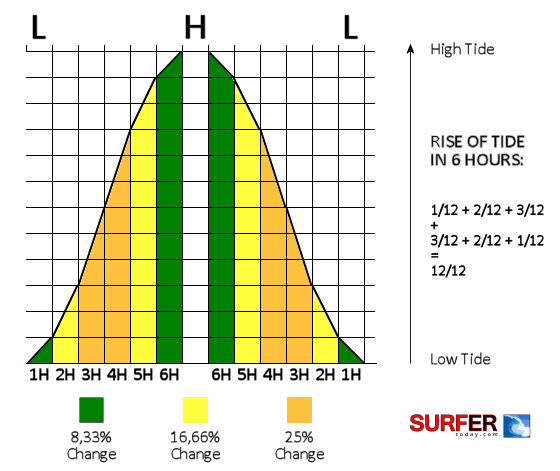How many times do you get perfect wind and wave conditions, but, frustratingly, the tide is too low or too high to surf? Learn the Rule of Twelfths and select the right time to go surfing.
Tides are a key factor when it comes to surfing and wave riding. Tide height affects the volume of water, or the depth of water, and the breaking of the waves.
If the tide is too high, incidences of closeouts increase, while if the tide's too low, waves can be mushy or slow-rolling.
That is why we must adapt to tides to get the most out of a surf session.
The Rule of Twelfths is a rule-of-thumb method for estimating the height of the tide at any given time.
It is based on the assumption that the change in the quantity being measured occurs in a sine curve shape and can be divided into twelve parts.
The rate of flow in a tide increases smoothly to a maximum halfway point between high and low tide before smoothly decreasing to zero again.
In other words, the Rule of Twelfths is often used as a quick and easy way to make approximate predictions about tidal heights or changes in each tidal cycle.
A Non-Linear Tidal Change
This means that in the first hours of a tidal shift, you may notice that the tide might not rise/fall so much, yet the entire process will accelerate through the mid-hours.
Tide times available on tide charts usually tell you the exact hour and minute of both low and high tide.
The Rule of Twelfths applies to the semidiurnal tide, i.e., a tide having two high waters and two low waters during a tidal day, which is exactly what happens in most locations.
The semi-diurnal tide period lasts for a period of 12 hours and 25.2 minutes from low to high tide and then repeats back to low tide again.
Learning which are the right moments to hit the surf - keeping in mind the Full/New Moons and First/Third Quarter Moons - will save you time and increase the quality of your session.
To use the rule, you need to know the time and height of high and low water and do some mental arithmetic to apply the rule.
How to Calculate the Rule of Twelfths
To calculate the rule of twelfths, you can follow these steps:
- Determine the difference in height between the high and low tide on a given day;
- Divide this difference by 12 to get the size of each "chunk" or increment in the sine curve;
- Use this chunk size to estimate the height of the tide at intermediate times between high and low water;
For example, if the high tide is 8 feet above chart datum and the low tide is 2 feet above chart datum, there is a 6-foot difference.
Dividing this difference by 12 gives a chunk size of 0.5 feet.
If you want to estimate the tide height at a time 3 hours after low water, you can use the rule of twelfths to calculate that the tide will be 1.5 feet above chart datum (3 chunks x 0.5 feet/chunk).
Another advantage of using it is that it does not require the use of complex tidal curves or graphs and can be used with just a basic understanding of math and the time and height of high and low water.
To know more about tide behavior and patterns, learn how the moon and the sun affect tides and surfing.
